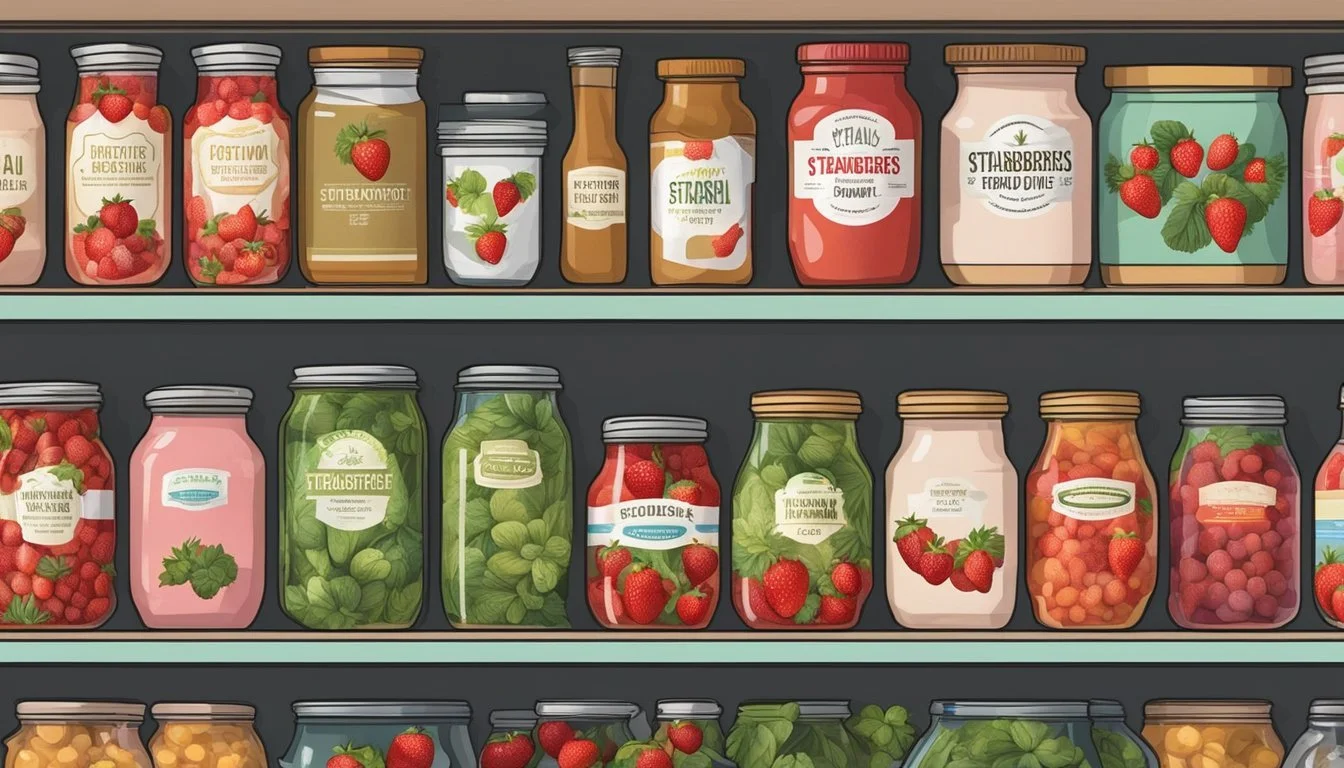How Many Cups in a Pint of Strawberries?
A Quick Measurement Guide
When measuring strawberries for recipes, it’s important to understand how volume and weight conversions work. A pint, a common measure for fruits and vegetables at the grocery store, can translate into various cup measurements depending on whether the strawberries are whole, sliced, or pureed. Knowing these conversions ensures accuracy in following recipes and can help when purchasing strawberries, making sure one has the right amount for their culinary needs.
With a pint of fresh strawberries, one can generally expect to have about 2 cups of whole small berries. If the recipe calls for sliced strawberries, the same pint might yield approximately 2.25 cups. When strawberries are pureed, the volume decreases slightly, providing around 1.25 cups from a pint. These conversions are essential for bakers and cooks who value precision in their ingredients, affecting the texture and consistency of the final dish.
It's also helpful to note that a pint of strawberries typically weighs around 3/4 pounds. However, this can vary slightly due to the size and variety of the strawberries. Different recipes may call for strawberries in terms of weight or volume, and understanding how to convert between the two ensures that one can adapt and use whatever measurement tools they have on hand.
Understanding Measurements
When dealing with recipes, it is crucial for the reader to comprehend the difference between units of volume and weight, as well as how these measurement systems are used in cooking, especially when converting between them.
Units of Volume
Volume measures how much space an ingredient occupies. Common units of volume used in cooking are:
Teaspoons (tsp)
Tablespoons (tbsp)
Cups (c)
Pints (pt)
Quarts (qt)
Gallons (gal)
For liquid ingredients, fluid ounces (fl oz) are also often used, which should not be confused with weight ounces. The metric system includes units such as milliliters (ml) and liters (l). When discussing strawberries, a pint equates to 2 cups of small whole strawberries. The following table outlines basic conversions:
Volume Unit Equivalent 1 cup 48 teaspoons 1 cup 16 tablespoons 1 pint 2 cups 1 quart 2 pints 1 gallon 4 quarts
Weight Versus Volume
Weight, on the other hand, refers to the heaviness of an ingredient and is typically measured in ounces (oz) or grams (g) for smaller quantities and pounds (lbs) for larger quantities. While volume measurements are more common for liquids, weight measurements are often preferred for dry ingredients due to the accuracy they provide.
For strawberries, understanding both volume and weight is important because the size and density of berries can vary. Therefore, one pint of strawberries can weigh approximately 3/4 pound (12 ounces or 357 grams). It is important to note that specific measurements can vary, depending on factors such as size and preparation method of the strawberries (whole, sliced, or pureed).
In the context of strawberries, it is clear that measuring by volume is more consistent for recipes since it reflects the actual space taken up by the berries regardless of their individual size or density. However, a shopper might buy strawberries by weight, requiring a conversion to volume for recipe use.
Strawberries as an Ingredient
In recipes, strawberries serve as a versatile ingredient that can be adapted to various forms, from whole to pureed. The amount of strawberries needed can vary based on the size and preparation method.
Strawberry Varieties
Different strawberry varieties can significantly affect the taste and texture of a recipe. Large strawberries are often juicy and have a bold flavor, suitable for fresh consumption and decorative purposes. In contrast, small strawberries can be sweeter and are perfect for garnishing and creating a more refined palate in dishes. Medium-sized strawberries find their use in between, versatile enough for both whole applications and pureeing.
Seasonal Availability
Strawberries are a seasonal fruit with peak availability during the spring and early summer; however, they can be found in grocery stores year-round. Fresh strawberries are favored in recipes for their optimal flavor and texture, but frozen strawberries are an alternative when fresh ones are out of season. Frozen strawberries work well in recipes that don't rely on the firm texture of fresh strawberries, such as in smoothies or jams. It's important to note that a pint of fresh strawberries generally converts to approximately 2 cups when whole and slightly less if they're sliced — 2 1/4 cups to be precise. Frozen strawberries can be measured similarly, although thawing may change the volume slightly due to excess water.
Measurement Conversions
When working with strawberries in recipes, it is essential to understand the conversions between cups, pints, quarts, and pounds. Kitchen accuracy ensures the best results, especially when baking or preserving.
Cups to Pints
1 cup of strawberries roughly equals 1/2 a pint.
Therefore, for a recipe that requires a pint of strawberries, one would need 2 cups.
Pints to Quarts
1 pint of strawberries is equivalent to 1/2 a quart.
To convert pints to quarts, simply double the number of pints; 2 pints are equivalent to 1 quart of strawberries.
Ounces to Pounds
There are 16 ounces (oz) in a pound (lb).
When considering strawberries:
12 ounces equal 3/4 of a pound.
Therefore, a pint of strawberries, which is commonly 12 ounces, also equals 3/4 pound.
Preparation and Usage
When preparing strawberries for recipes, the accurate measurement is crucial. The reader should be aware that measuring strawberries can vary based on whether they are whole, sliced, or puréed, and that their state (fresh, frozen, or dried) also plays a significant role in the measuring process.
Measuring Techniques
When measuring strawberries, the tool of choice is typically a standard measuring cup. For whole strawberries, a pint equates to approximately 2 cups. If a recipe calls for sliced strawberries, a pint translates to about 2 1/4 cups. When pureed, a pint of strawberries is roughly equal to 1 1/4 cups. The process of measuring strawberries for cooking and baking can be summarized in the following list:
Whole Strawberries:
1 pint = 2 cups whole berries
Sliced Strawberries:
1 pint = 2 1/4 cups sliced berries
Pureed Strawberries:
1 pint = 1 1/4 cups pureed berries
To ensure accuracy, it's recommended to fill the measuring cup and level off the top for a precise measure.
Cooking and Baking
Strawberries are a versatile ingredient and can be used in a variety of culinary applications. For baking, precise measurements are imperative to achieve the desired outcome. The moisture content of frozen strawberries may differ from that of fresh ones, therefore, when using frozen, one must account for excess liquid.
In cooking, strawberries can be more forgiving, but knowledge of strawberry equivalents is helpful. For instance, if a recipe requires a specific measurement of strawberries in cups, it's important to know whether to measure them whole, sliced, or pureed. Cooks should consider the following when using strawberries in their dishes:
Frozen Strawberries: Take into account the additional moisture when substituting for fresh.
Baking: Measure accurately to ensure the best texture and flavor of the final product.
Through proper measuring and preparation techniques, the culinary uses of strawberries can be fully maximized while maintaining flavor integrity.
Storage and Preservation
When handling strawberries, it's crucial to employ effective storage and preservation methods to maintain their freshness and extend their shelf life. Proper techniques can prevent spoilage and ensure that the fresh fruit retains its quality for longer periods.
Storing Strawberries
To store strawberries in the refrigerator, one should first remove any spoiled or damaged berries to prevent them from affecting the good ones. The strawberries should be placed in a single layer on a paper towel-lined tray or plate to absorb excess moisture. Covering them with plastic wrap is advisable; however, they should not be washed until just before consumption to prevent molding. Using containers that allow for air circulation can also help preserve their freshness. The optimal refrigerator temperature for strawberries is between 32°F to 36°F (0° to 2°C).
Method Container Temperature Additional Tips Refrigerating Plastic with airflow 32°F to 36°F Single layer, lined with paper towel
Freezing Strawberries
To freeze strawberries, one should first wash and hull them, then pat them dry. They can be placed on a baking sheet in a single layer and frozen until solid to prevent the berries from sticking together. Once frozen, the strawberries should be transferred to airtight, freezer-safe containers or bags to prevent freezer burn. Label the containers with the date of freezing. Strawberries can be frozen whole, sliced, or crushed, depending on future use. Freezing at 0°F (-18°C) is ideal for long-term storage.
Method Preparation Container Temperature Freezing Washed, hulled, dried Airtight, freezer-safe 0°F (-18°C)
By following these methods, one can ensure that fresh strawberries from farmers markets or a farm harvest are well-preserved for future enjoyment.
Shopping for Strawberries
When shopping for strawberries, accurate measurements and quality are crucial. Understanding how strawberries are sold in markets or grocery stores ensures you purchase the right amount for your needs without compromising on the quality of the fruit.
Selecting the Right Quantity
When purchasing strawberries, they are often sold by volume in pints, quarts, or by weight in pounds. A pint of strawberries is a common measure you might encounter, and it can be helpful to know that one pint is typically equivalent to:
2 cups of whole small berries
Approximately 12 large, 24 medium, or 36 small strawberries
If buying in bulk for larger recipes or storage, strawberries can also be found in packages such as a half-flat or by the pound. A good tip is to remember that a quart of strawberries is about twice the amount of a pint.
Evaluating Quality at Purchase
Inspecting the strawberries’ quality at the market or farm is fundamental. When selecting a basket or package of strawberries, look for:
Bright and uniform red color: This indicates ripeness and sweetness.
Firmness: Soft spots might suggest overripe or spoiling berries.
Fresh and green leaves: Wilted leaves could imply they've been sitting out for a while.
It's best to avoid berries with mold or those that are shriveled, as these qualities hint at age and potential spoilage. If berries are pre-packaged, check if the container allows for some space for the berries to breathe and avoid any packages that look crushed or with excessive moisture, as this could speed up decay.








